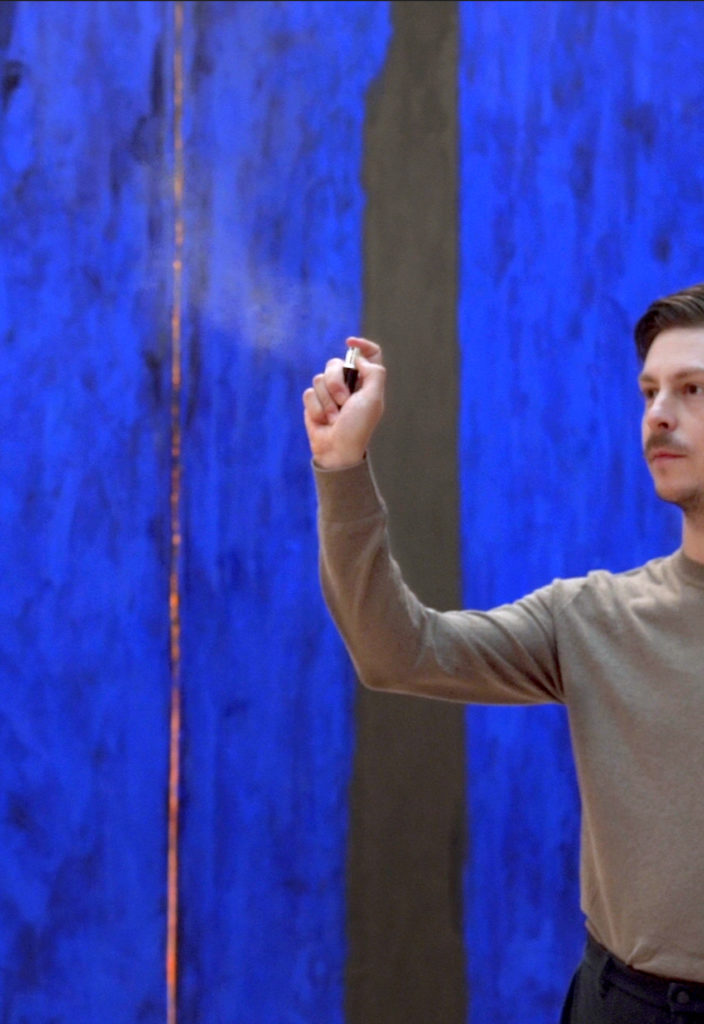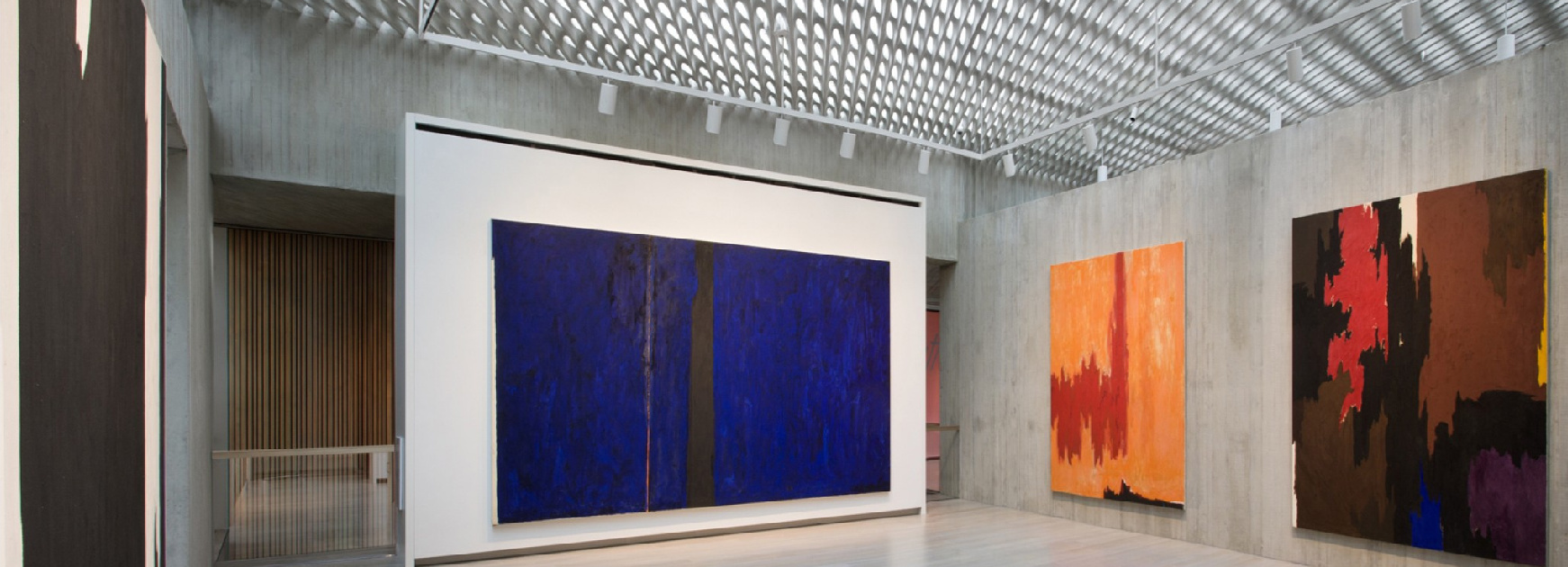Over the past 18 months, CSM has partnered with artist Adam Milner on a project called Museum of the Invisible Woman and other essays and actions. This multi-disciplinary collaboration combines archival research with in-situ interventions at the Museum, all of which will result in a publication designed in collaboration with the artist to be published later this year.
Milner’s often private actions within the Clyfford Still Museum have considered issues of solitude, intimacy, gender, and legacy. In late 2018, Milner spent an entire night awake in the Museum shadowing security guards. He returned last spring to spend another night in the Museum, considering the paintings in darkness. Most recently, Milner scented the galleries with two vintage perfumes matching those discovered in the archives, which the Museum believes were worn by Patricia Still—Still’s second wife, closest confidant, and manager of Still’s affairs. Through this performative action, Milner imbues the Museum with Patricia Still’s presence as a means of honoring and articulating her position in Still’s life and career, thus complicating the romantic illusion of the lone genius artist. By bringing attention to the overlooked figure of Patricia Still, Milner provokes the question of who else has been integral to art, artists, and art history, but may have been denied prominence for various reasons.
Below are excerpts from a recent conversation between Milner and CSM Director Dean Sobel:
Sobel: The Clyfford Still Archives were a touchstone for your project, though I don’t think either of us expected that they would fuel so many ideas for you. Can you talk about your ongoing research in the Archives and how that shaped your thinking?
Milner: I was interested in what I could learn from the various facets of the Museum that keep it operating—security, conservation, archives, etc. Working as a researcher in the archives was partly a way to work in the Museum without foregrounding my role as an artist, but as something else. Operating within a single artist museum is a difficult combination of resistance and collaboration, so I went in as a kind of researcher. The archives—being this dense web of thoughts, fears, and desires, taking the form of letters, diaries, and research images—became a way to hallucinate within a kind of collective brain that makes up the man “Clyfford Still,” but which in fact is made up of many other people as well.
Sobel: You found some rather interesting and unusual archival materials during your research, particularly items connected to Still’s second wife and closest confidant, Patricia. Can you tell us some more about that?
Milner: I learned of a pair of perfumes tucked inside a box of documents: Nina by Nina Ricci and Aphrodisia by Fabergé, apparently belonging to Patricia Still. Patricia is an important figure for me. While Still is known as an outsider or rebel, someone whose relationships with other artists, dealers, and critics were exceptionally fraught, there was always Patricia. She is all over the archives and Museum already—her handwriting, systems, and methods. The Museum is as much a product of her labor as anyone’s. I found it so smart and maybe even subversive of her to include her own perfumes in the archives. Perfume is gendered, it’s bodily, but most importantly it is fugitive. The scent of the perfumes began to seep into their surroundings, permeating this box of art historical clippings and writings. This woman who gets almost no credit in the narrative was hanging in the air like a ghost—the archives began to smell a bit like her. So, I filled the whole Museum with her scent. Finding the perfumes was the moment I realized this project had to be about the people behind the scenes—by giving them some attribution, the myth of the lone genius artist disintegrates. This myth is a problem because it erases ideas of community, vulnerability, and love.

Sobel: Your actions also involved and sometimes bumped up against various Museum policies and in some cases, I suppose, norms. How did that inform your thinking about this project?
Milner: Fears of museums can reveal their priorities, their insecurities, and their hopes, far more than any mission statement can. For one of my first museum exhibitions, I made a bedroom for me and anyone else to sleep in—I heard through a grapevine of visitor service representatives that I was not allowed to have sex in the museum. When I intervened into the archives of The Warhol, fears of contamination pervaded our conversations. By pushing the boundaries of what’s allowed in the museum, I can learn a lot about its power structures and what it’s attempting to do. And also how the museum views me, which is an interesting mirror into how my practice is understood by these institutions. At the Clyfford Still Museum, can we open the galleries at night? Can I light the paintings with candles instead of overhead bulbs? Can I sleep in painting storage or conservation or the director’s office? Can I infiltrate security? The nos and yeses both create a lot of perspective of boundaries, but also momentum in the project.
Sobel: Your actions, photo-documentation, and ephemera are currently being culled into a publication, closer to the tradition of a livre d’artiste. Can you say a bit more about that for our readers and touch on why that type of document interested you more than, say, an exhibition or even a more traditional “catalogue?”
Milner: As I researched in the archives and created these quiet interventions, I started to think of my experience in the Museum through the lens of a set of essays. I think it’s important to write about artists and art history from different perspectives. Still has had ample writing, but always from a similar vantage point of the art historian with Ab-Ex expertise. What does it mean for me to write from my perspective: as an artist, a queer, a former museum employee, as someone critical of legacy, ego, and the myths that surround art-making? And we have other writers contributing as well, which further complicate ideas of authority on the subject. I don’t actually view this book as outside the norm of any book that might be published about an artist, though I suppose I am doing it my way. At the end of the day, books are small, intimate objects which exist in multiples and can easily circulate. That seems important here.
Sobel: How does this project relate to your other current exhibitions?
Milner: At the center of all the work is a notion of care. With the Clyfford Still Museum I want to know more about who cared about this outsider, who truly loved him and supported him. And that relates to how the Museum cares for the paintings but also how or if we care about the employees or workers who make up these institutions. In my exhibition “Taking good care of your things leads to taking good care of yourself” at the Mattress Factory [up through March], I look at how we treat the things around us by cradling things inside of things inside of things through various methods of carving and casting. Customized containers point to a careful consideration of the thing they’re holding, but containers can also stifle or control. In that show, a small wasp is held by a carved stone which is held by carved marble which is held by a bed I made, but if you keep going out from there, you realize the gallery is a container, the museum too. I incorporated a lot of items from the museum’s history in my exhibition, including works by other artists and ephemera belonging to the founders. While working with the museum, they experienced a reshuffling of leadership due to how a string of sexual assault allegations were mishandled. Because it’s a museum dedicated to site-specificity, it was important to acknowledge all the good and bad of the museum’s history related to ideas of care. For me, in all of these instances, the museum is not only a site for work to go, but is an important subject itself.
Adam Milner (b. 1988) creates sculptures, drawings, texts, videos, and interventions which focus on collections—his own as well as those of institutions—to examine desire and its relationship to power, access, conquest, technology, and the body. He has exhibited at the Andy Warhol Museum, the Aspen Art Museum, David B. Smith Gallery, the Mattress Factory, MCA Denver, Casa Maauad (Mexico City), and Galería Mascota (Mexico City), among other venues. Milner lives and works in Brooklyn.
Dean Sobel is the founding director of the Clyfford Still Museum. Prior to this post Sobel was director and chief curator at the Aspen Art Museum and, before that, chief curator at the Milwaukee Art Museum, where he held the joint position of Curator of Contemporary Art.
